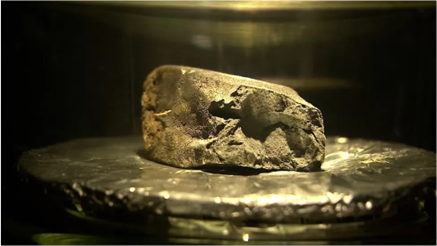My kids are of an age (12 and 13) where science is both simultaneously daunting and eye opening on a daily basis. The older one is just starting to learn about atoms and elements, giving me ample opportunity to regale her with information about the instruments I work with, whilst giving her ample opportunity to roll her eyes. She now “gets it” that these instruments are used to measure how much of the different versions (her words, she means isotopes of course) of an element are in a rock sample. But an obvious question she asked was: “how come they need a great big instrument that costs more than our house, just to measure those versions?”

Fair question! So I thought that as we’re heading into the silly season – I mean festive season – I’d address that in my own terms. Therefore, this blog is about TIMS; not really the sciencey stuff, but an exploration of why these things cost as much as a house and why we can’t just measure those isotopes using a classroom microscope. This is of course a blog and thus a personal opinion rather than a company statement. You can address any questions, comments or corrections directly to me (Stephen.guilfoyle@isotopx.com).
I’m assuming that anyone taking the time to read this blog has a scientific education and knows all the good stuff about elements and isotopes. In our community, the amount of certain isotopes present in a sample helps to tell us about the history and origin of that sample. Often this is not very glamorous research, but occasionally it ventures into the public awareness, such as the meteorite that landed in the south of the UK recently. This sparked a fair amount of media interest, which resurged once it was discovered that the meteorite contained water with hydrogen isotope ratios similar to water on Earth (UK BBC news article here)

So if we accept that isotopes are important, why are they hard to measure? My daughter is just grasping that the isotopes are chemically identical, thoroughly mixed, and typically extremely hard to separate into pure, single-isotope forms. This is difficult enough when your element is a gas, but really challenging when it’s a lump of heavy metal. Think how much the elves struggled to mix mithril with silver and gold in the recent Lord of the Rings series (poor analogy, but I’m aiming for the youth market here).
I explained to my daughter that if we’re limited to school science room tech, separating out those isotopes by hand would essentially involve breaking down the sample into atom-sized pieces, weighing each of them, and putting them into neatly labelled pots, one for each isotope. Nobody has time for this, least of all kids. So that’s where isotope ratio mass spectrometry comes in – even if they’re not high up on most kid’s Christmas lists.
When you’re describing the use of a magnetic sector to separate ions by mass to charge, the rainbow (or better still, prism) analogy works very well. If you are of my generation then if you have a copy of Pink Floyd’s Dark Side of the Moon then you’re sorted. Of course, we also know that the magnets with enough power to do this are BIG. And by BIG we mean HEAVY. My kids are fascinated that the magnet to do this job on a typical thermal ionization mass spectrometer weighs half a ton. Or in more appreciable units, 100,000 Haribo Sours.

Bearing in mind the size of this magnet, the frame to mount the mass spectrometer is already looking pretty hefty. And then we get to the vacuum system. This one is a bit harder to explain to kids; why on Earth do we need to suck out all of the air? I use the shopping centre analogy.
Imagine you are in a huge, out of town shopping centre, the kind that kids used to love hanging around in. Let’s say you’ve just spotted the retina-searing glow of the Smiggle store. You head in that direction, because you’re meeting all the other 11 year old kids there. But its’ nearly Christmas, and the shopping centre is full of old people (i.e. anyone over 13), you keep banging into them. They eventually cause you to divert off track, away from Smiggle, and suddenly you are in a book shop. Yuk, how did that happen!

Bear with me here… The vacuum system is akin to sucking all of those annoying grown-ups out of the shopping centre, meaning a direct and unhindered path straight to Smiggle. In other words, the vacuum system ensures that as much of the “stuff” that you put into the mass spectrometer comes out the other end, in the right place at the right time. Simply put, without the vacuum system the mass spectrometer won’t work.

But the vacuum system is also heavy, and very complicated. And even kids know that “complicated” usually means “expensive”. Then we get to the control electronics, the ion source, the sample carousel… all of which are highly engineered, complicated, and of course expensive. And we haven’t even got on to the detector part, possibly the most complex and highly engineered part of the whole instrument.
Putting all of this together, you end up with a large machine, weighing as much as a big car, that costs as much as a nice house – the kind that the rich girl in year nine with the posh accent lives in. This is the bit my kids still struggle with. But there is a glimmer of hope: like a lot of kids their age, mine are becoming increasingly aware of climate change, environmental concerns, and the damage that humans are causing to our planet. So I’m able to (truthfully) say that instruments like ours are used by world-leading scientists to help understand climate change. Now they get it!
In summary, in this blog I’ve managed to trivialize what is a highly developed and powerful technique. Let’s agree to blame it on Christmas. In a forthcoming blog I’ll address that by taking a more serious look at some of the technology used in TIMS. And I promise there will be no mention of Smiggle.
If you have a comment about this post, wish to point out an error or addendum, or just want to send me a Christmas card, please let me know here: (Stephen.guilfoyle@isotopx.com).
